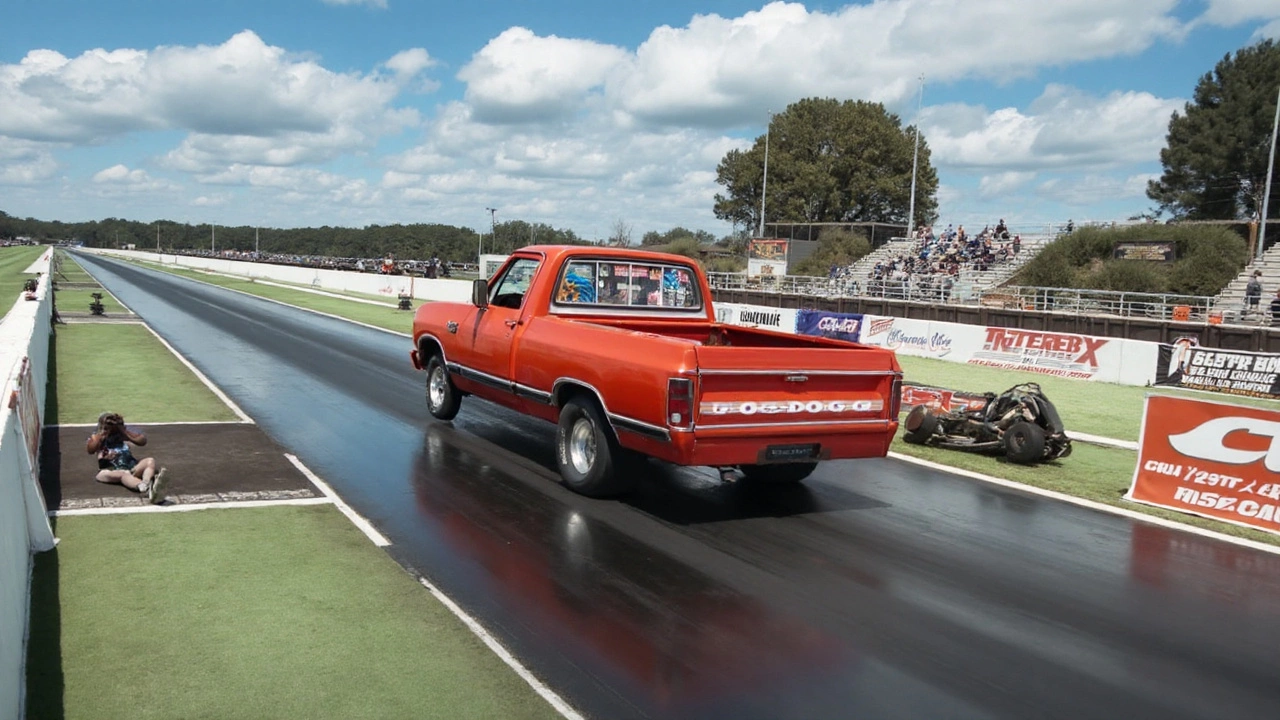A 1987 Ram puts Stellantis’ inline-six on the map
A 1987 Dodge Ram D150 just did what many die-hard Hemi fans didn’t expect: it ran a 9.39-second quarter mile at 140 mph with a 3.0-liter inline-six under the hood. Not a big V8. Not nitrous. A boosted six. The truck, built by Morgan Evans and Jason Kastner of the Torque n’ Tungsten YouTube channel, pairs old-school steel with Stellantis’ modern Hurricane engine, and the results are hard to ignore.
The numbers are clean and loud: 802 horsepower and 740 lb-ft of torque on a stock long block. The duo binned the factory twin-turbo layout and went with a single Precision Next Gen 6870—an aftermarket favorite that’s rated for around 1,200 horsepower worth of flow. That gives them headroom, and the pass at 9.39 seconds shows they’re using the setup well. It’s not just a dyno queen either. After winning the Grudge Match at Roadkill Nights during the Woodward Dream Cruise, they racked up about 1,200 miles on Michigan roads with more racing sprinkled in.
Let’s call out the hardware choice first. Swapping from factory twins to a big single changes everything—packaging, thermal load, and power delivery. A single 6870 means fewer heat sources and simpler plumbing, but it demands smart manifold design, wastegate control, and charge-air cooling. Evans and Kastner fabricated new exhaust manifolds, built custom plumbing, and tailored the whole system so the turbo sees clean, consistent flow. That kind of work separates fast cars from fast-for-one-pass cars.
The heart of the build is still the factory Hurricane long block. That’s the headline. If you can run deep into the 9s without opening the engine, you’re tapping into built-in strength: a rigid bottom end, modern oiling, direct injection, and tight knock control. You’re also benefiting from efficient combustion that helps keep EGTs and detonation in check at high boost. This is exactly why tuners once fell in love with Toyota’s 2JZ—dense power without drama.
And yes, the 2JZ comparison fits. Toyota’s iron-block six became legend because it held boost, took abuse, and lived to do it again. The Hurricane is a different animal—lighter, newer, and designed for emissions and fuel economy—but the tuning story feels familiar. Strong core. Big turbo potential. Growing community. The Mopar world finally has an inline-six that can play that game.
Context matters here. Stellantis spent the last couple of years nudging customers away from V8s in mainstream models, which frustrated a loyal base that equates Mopar with Hemi. The Hurricane is the bridge: better efficiency, cleaner emissions, and—judging by this truck—serious speed when you want it. With the 2025 Ram 1500 moving to Hurricane power in place of the 5.7 Hemi in most trims, a build like this doesn’t just make noise; it makes the future easier to picture.
Roadkill Nights is where the truck made its public statement. Legal street-style drag racing, big crowds, and a lineup of high-power builds. The Torque n’ Tungsten Ram didn’t just show up—it won the Grudge Match. Then, instead of heading back on a trailer, it drove around the state and kept racing. That’s the part that will stick with tuners: the reliability stretch. Power is easy; power that survives a road trip is the real test.
What’s behind that reliability? Start with the turbo choice. Precision’s 6870 has the airflow to make four-digit power, but you don’t have to run it maxed out. Running a large turbo at moderate pressure ratio can keep charge temps manageable and reduce stress. Couple that with solid intercooling, clean fuel delivery, and careful timing, and you get repeatable performance. The team’s custom manifolds also matter—good pulse energy to the turbine helps drive power without needing brutal boost levels.
Plumbing and packaging are the unsung heroes. On a swap like this you’re solving space issues around steering shafts, frame rails, and firewall clearance. You’re routing oil feeds and drains so the turbo stays healthy. You’re managing heat around brake lines, wiring, and the cabin. Evans and Kastner didn’t just bolt parts on; they built a system. That’s why it looks tidy and runs hard.
The ECU side is where modern engines often scare people off. Factory control units are tied into security, body modules, and emissions logic. Tuners get around that with reflash tools, standalone engine management, or a hybrid approach that keeps key factory sensors talking while letting boost and fuel be commanded cleanly. The builders haven’t published every detail of their control strategy, but the drivability and track results suggest the calibration is sorted.
So what does a 9.39 at 140 tell us? First, the mph says the truck is making the power it claims. Trap speeds in that range line up with roughly 800-plus wheel horsepower in a typical rear-drive vehicle, depending on weight and aero. Second, the time slip says they’re getting the launch and the first 60 feet under control—no easy task with a short-wheelbase pickup and big torque. That points to a transmission and rear setup that can take hits without grenading, plus a suspension that puts weight where it needs to be.
Why does this matter beyond one very fast pickup? Because it shows the Hurricane can be a tuner platform, not just an OEM workhorse. The formula that built the 2JZ myth wasn’t just Supra owners making 1,000 horsepower. It was a whole ecosystem: tuners, machine shops, turbo suppliers, and a pile of how-to knowledge. That’s what the Mopar crowd has lacked for a modern inline-six. Builds like this are the spark that grows an aftermarket.
We should also talk about what makes an inline-six so good for tuning. Balance is a big one. Inline-sixes fire every 120 degrees and don’t need balance shafts, so they’re inherently smooth. That smoothness helps at high rpm and under boost. They also package turbos nicely on one side of the engine bay, which simplifies hot-side plumbing. In trucks with big engine bays—like the D-series—there’s room to breathe, and that makes a single big turbo especially attractive.
Single versus twins is a debate that never ends. Twins give you near-instant response and split the heat load, which is great for heavy vehicles and towing. Singles give you simpler packaging and often more top-end headroom. For a drag-first build, a single like the 6870 makes sense. Down the line, if they chase four-figure power, they’ve got room to grow without changing the core layout.
The broader Stellantis angle is straightforward. Regulations are getting tighter, trucks are getting heavier, and customers still want speed. The Hurricane lets Ram, Jeep, and Dodge offer big torque and high output without leaning on a 6.2-liter supercharged V8 in every performance trim. It also leaves space for electrified add-ons later. For enthusiasts, that means there’s a path to fast, factory-backed sixes—and, judging by this truck, a path to 9s when you go all-in.
There are hurdles, of course. Engine availability and cost will matter. The learning curve on tuning direct-injected, turbocharged sixes is steeper than old small-blocks. And the rest of the drivetrain needs to keep up: strong automatics, proper converters, good cooling, and smart traction aids. But these are solvable problems. This D150 shows the payoff when you solve them.
If you’re thinking about what comes next, the roadmap is obvious. More boost and more fuel will chase four-digit power. At that point, the limits of the stock long block will become the story. Will rods, pistons, and head sealing keep up? That’s where the aftermarket steps in with forged parts and upgraded fasteners. What’s encouraging is that the baseline is already this good without cracking the case.
For Mopar fans worried about character: the sound is different, but the feel is still there. Big torque. Big thrust. A truck that leaves hard and hangs on in the big end. The difference is how it makes the power—more whoosh than roar—and how manageable it is between stoplights. The 1,200-mile Michigan trip says this isn’t a brittle setup. It’s streetable, which is where real enthusiasts live most of the time.
Here are the key takeaways from the build so far:
- 1987 Dodge Ram D150 with a 3.0-liter Hurricane inline-six swap
- Single Precision Next Gen 6870 turbocharger replacing the factory twin-turbo approach
- 802 hp and 740 lb-ft on a stock long block
- 9.39-second quarter mile at 140 mph—current Hurricane platform record
- Won the Grudge Match at Roadkill Nights during the Woodward Dream Cruise
- Completed roughly 1,200 miles of street driving and additional racing afterward
The 2JZ parallel will keep coming up, and that’s fine. The Toyota engine earned its status over decades. The Hurricane is new, and one truck doesn’t crown a king. But this Ram shows the blueprint: durable core, smart turbo choice, careful fabrication, and calibration that respects heat and fuel. If more builders follow, the Mopar six could build the same kind of legend—the kind measured in time slips and miles, not just dyno graphs.
For Stellantis, this is a useful calling card. It proves that the engine replacing V8s in mainstream trucks can be a genuine performance platform. For the community, it’s a nudge to start sharing maps, parts lists, and lessons learned. The next wave is coming—more swaps, more records, and more data. That’s how a platform moves from promising to proven.



